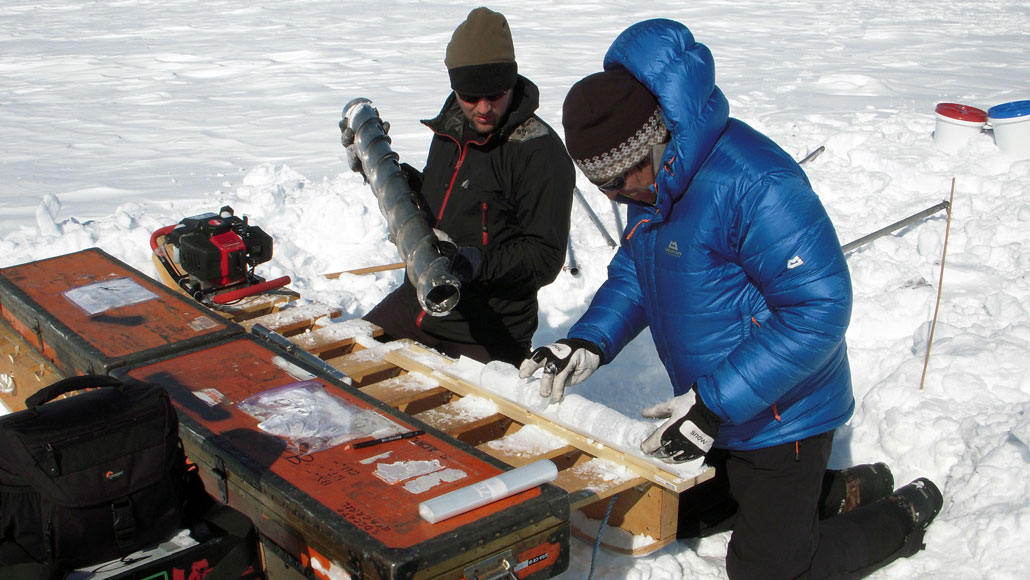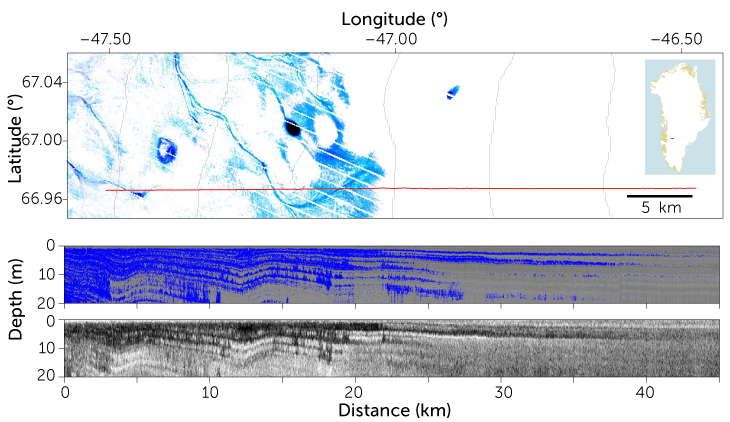
Ice cores drilled in 2012 into the Greenland ice sheet revealed large, meters-thick ice slabs beneath the snow.
Babis Charalampidis/Bavarian Academy of Sciences and Humanities, Germany, Geological Survey of Denmark and Greenland (© 2012 GEUS)
- More than 2 years ago
Hidden slabs of frozen meltwater have grown rapidly beneath Greenland’s snowy surface since 2001, scientists say. And these ice slabs are amping up the ice sheet’s contribution to rising seas.
By forcing more meltwater to run along the surface and pour directly into the sea, the impermeable slabs could increase Greenland’s contribution to global sea level rise from seven to 74 millimeters by 2100, depending on future greenhouse gas emissions, simulations suggest. So far, additional meltwater runoff due to the slabs has contributed about one millimeter to global sea levels, researchers report in the Sept. 19 Nature.
Greenland’s melting, set off by global warming due to higher levels of carbon dioxide and other greenhouse gases in the atmosphere, has increased dramatically in the last few decades. Since 1972, the island has contributed about 14 millimeters to sea level rise, but much of that melting occurred after the turn of the century.
Record-breaking summertime melting occurred in 2002, 2007, 2012 and most recently, 2019, says Michael MacFerrin, a glaciologist at the University of Colorado Boulder (SN: 8/2/19). Some of that meltwater refreezes in the wintertime, forming thick, impermeable layers of ice around Greenland’s perimeter that can stretch for tens of kilometers, MacFerrin and colleagues say. The team dubbed the layers “ice slabs” in their new study.
Typically, summer meltwater can seep back into the ice sheet, trickling down into porous, partially compacted layers of granular snow called firn. Sometimes, pockets of meltwater within the firn refreeze into small, scattered bodies of hard ice, called ice lenses.
It was while drilling for ice cores in 2012 in southwest Greenland that MacFerrin and colleagues first determined that instead of isolated lenses, there might be widespread layers of frozen ice just beneath the surface. “We did not expect to find meter after meter after meter of solid ice,” MacFerrin says. Those ice slabs, the team suggests, act as an effective barrier to percolating meltwater, funneling the water more quickly to the ocean.
To map the slabs’ extent, MacFerrin and colleagues examined five years of airborne radar observations collected by NASA’s Operation IceBridge mission from 2010 to 2014 (SN: 3/11/11). The team also created their own images of the subsurface in 2013 using ground-penetrating radar, or GPR. The radar pulses generated by GPR can distinguish between, for example, water-saturated firn layers and impermeable layers of ice.
Refrozen ice
To visualize ice slabs beneath Greenland’s surface, researchers used radar data from NASA’s IceBridge mission as well as ground-penetrating radar, or GPR. The red line shows the GPR transect followed by the researchers. Blue regions indicate water resting on the ice surface, shown in the satellite image at top. The GPR data, shown in the middle, reveal layers of refrozen ice, or ice slabs, colored in blue, down to 20 meters below the surface. At bottom are the IceBridge data along the same line and showing similar extents for ice slabs (black).
Vast ice slabs extend under parts of Greenland

Combining those data, the team created a map of the horizontal and vertical extent of the subsurface ice slabs across the entire island. In 2014, they found, ice slabs covered between 64,800 and 69,400 square kilometers, about 4 percent of the ice sheet’s total area. The slabs were between 1 meter and 16 meters thick.
Those observations, as well as the core data collected in 2012 and climate data, helped the team simulate past growth of the slabs, back to the 1990s. It wasn’t until the beginning of the 21st century that slab growth really took off, MacFerrin says, noting that “2002 was a record-breaking year of melt in Greenland. That’s when these big solid layers started freezing, and they have been expanding since then.”
From 2000 to 2013, the formation of ice slabs has added to Greenland’s total runoff area by about 26 percent, the team found. Simulations suggest that in 2000, slabs spanned between about 500 and 3,300 square kilometers; by 2013, slab area was between about 62,100 and 78,900 square kilometers.
The team also projected slab growth up to the year 2100. Because there are different computer simulations of future climate conditions in the Arctic, as well as different projections of future global greenhouse gas emissions, the team ran numerous projections to estimate maximum and minimum numbers of slab growth.
“Under the lower greenhouse gas emission scenario, in which greenhouse gas emissions are reduced around 2050, we see ice slabs growing through the middle of the century and then the process slows down,” MacFerrin says. But under the highest future emissions scenario, in which current emissions are not reduced, slab growth could extend all the way to the center of the ice sheet.
That’s a sea change for Greenland, MacFerrin says. The fringes of Greenland’s ice sheet are known to be rapidly melting (SN: 4/3/18). “But the majority of the interior has been pretty stable,” he says. “Now we’re watching an ice sheet transform itself before our eyes…. The cold, boring interior of Greenland is waking up.”
Increased meltwater runoff due to ice slabs might also have a deeper impact on Greenland by changing the internal dynamics of the ice sheet, says Laura Stevens, a glaciologist at Columbia University’s Lamont-Doherty Earth Observatory in Palisades, N.Y. Those extra rivulets of meltwater pour into lakes and streams on the surface of the ice, but might also find ways to sink much deeper via cracks and crevasses — possibly all the way down to the base of the ice sheet, where it meets land, she says.
Adding meltwater to the base of the ice sheet could act as a kind of lubricant, possibly speeding up the flow of the ice sheet itself toward the ocean. For now, there’s too little information about how the ice slabs, meltwater and ice sheet might be interacting to say whether such a scenario is realistic or likely, Stevens adds. But, she says, this study reveals that the role of ice slabs is another line of evidence that scientists should collect in order to know the fate of Greenland’s ice.







